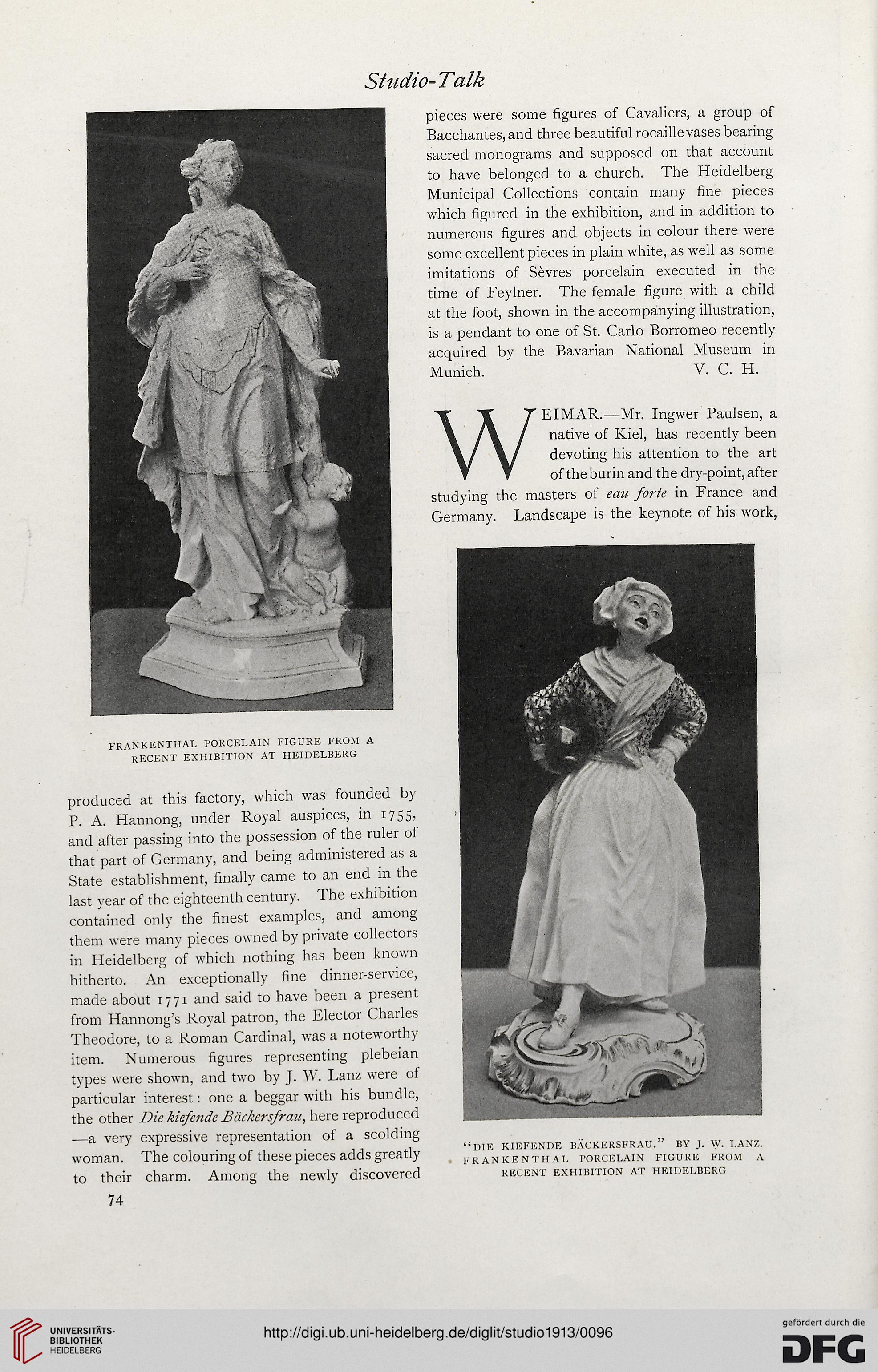Studio-Talk
FRANKENTHAL PORCELAIN FIGURE FROM A
RECENT EXHIBITION AT HEIDELBERG
produced at this factory, which was founded by
P. A. Hannong, under Royal auspices, in 1755,
and after passing into the possession of the ruler of
that part of Germany, and being administered as a
State establishment, finally came to an end in the
last year of the eighteenth century. The exhibition
contained only the finest examples, and among
them were many pieces owned by private collectors
in Heidelberg of which nothing has been known
hitherto. An exceptionally fine dinner-service,
made about 1771 and said to have been a present
from Hannong’s Royal patron, the Elector Charles
Theodore, to a Roman Cardinal, was a noteworthy
item. Numerous figures representing plebeian
types were shown, and two by J. W. Lanz were of
particular interest: one a beggar with his bundle,
the other Die kiefejide Bcickersfrau, here reproduced
—a very expressive representation of a scolding
woman. The colouring of these pieces adds greatly
to their charm. Among the newly discovered
74
“DIE KIEFENDE BACKERSFRAU.” BY J. W. I.ANZ.
. FRANKENTHAL I’ORCELAIN FIGURE FROM A
RECENT EXHIBITION AT HEIDEI.BKRG
pieces were some figures of Cavaliers, a group of
Bacchantes, and three beautiful rocaille vases bearing
sacred monograms and supposed on that account
to have belonged to a church. The Heidelberg
Municipal Collections contain many fine pieces
which figured in the exhibition, and in addition to
numerous figures and objects in colour there were
some excellent pieces in plain white, as well as some
imitations of Sevres porcelain executed in the
time of Feylner. The female figure with a child
at the foot, shown in the accompanying illustration,
is a pendant to one of St. Carlo Borromeo recently
acquired by the Bavarian National Museum in
Munich. V. C. H.
WEIMAR.—Mr. Ingwer Paulsen, a
native of Kiel, has recently been
devoting his attention to the art
of the burin and the dry-point, after
studying the masters of eau forte in France and
Germany. Landscape is the keynote of his work,
FRANKENTHAL PORCELAIN FIGURE FROM A
RECENT EXHIBITION AT HEIDELBERG
produced at this factory, which was founded by
P. A. Hannong, under Royal auspices, in 1755,
and after passing into the possession of the ruler of
that part of Germany, and being administered as a
State establishment, finally came to an end in the
last year of the eighteenth century. The exhibition
contained only the finest examples, and among
them were many pieces owned by private collectors
in Heidelberg of which nothing has been known
hitherto. An exceptionally fine dinner-service,
made about 1771 and said to have been a present
from Hannong’s Royal patron, the Elector Charles
Theodore, to a Roman Cardinal, was a noteworthy
item. Numerous figures representing plebeian
types were shown, and two by J. W. Lanz were of
particular interest: one a beggar with his bundle,
the other Die kiefejide Bcickersfrau, here reproduced
—a very expressive representation of a scolding
woman. The colouring of these pieces adds greatly
to their charm. Among the newly discovered
74
“DIE KIEFENDE BACKERSFRAU.” BY J. W. I.ANZ.
. FRANKENTHAL I’ORCELAIN FIGURE FROM A
RECENT EXHIBITION AT HEIDEI.BKRG
pieces were some figures of Cavaliers, a group of
Bacchantes, and three beautiful rocaille vases bearing
sacred monograms and supposed on that account
to have belonged to a church. The Heidelberg
Municipal Collections contain many fine pieces
which figured in the exhibition, and in addition to
numerous figures and objects in colour there were
some excellent pieces in plain white, as well as some
imitations of Sevres porcelain executed in the
time of Feylner. The female figure with a child
at the foot, shown in the accompanying illustration,
is a pendant to one of St. Carlo Borromeo recently
acquired by the Bavarian National Museum in
Munich. V. C. H.
WEIMAR.—Mr. Ingwer Paulsen, a
native of Kiel, has recently been
devoting his attention to the art
of the burin and the dry-point, after
studying the masters of eau forte in France and
Germany. Landscape is the keynote of his work,




